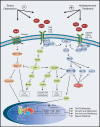Depression and treatment response: dynamic interplay of signaling pathways and altered neural processes
- PMID: 22585060
- PMCID: PMC3952234
- DOI: 10.1007/s00018-012-1020-7
Depression and treatment response: dynamic interplay of signaling pathways and altered neural processes
Abstract
Since the 1960s, when the first tricyclic and monoamine oxidase inhibitor antidepressant drugs were introduced, most of the ensuing agents were designed to target similar brain pathways that elevate serotonin and/or norepinephrine signaling. Fifty years later, the main goal of the current depression research is to develop faster-acting, more effective therapeutic agents with fewer side effects, as currently available antidepressants are plagued by delayed therapeutic onset and low response rates. Clinical and basic science research studies have made significant progress towards deciphering the pathophysiological events within the brain involved in development, maintenance, and treatment of major depressive disorder. Imaging and postmortem brain studies in depressed human subjects, in combination with animal behavioral models of depression, have identified a number of different cellular events, intracellular signaling pathways, proteins, and target genes that are modulated by stress and are potentially vital mediators of antidepressant action. In this review, we focus on several neural mechanisms, primarily within the hippocampus and prefrontal cortex, which have recently been implicated in depression and treatment response.
Figures


References
-
- Little A. Treatment-resistant depression. Am Fam Physician. 2009;80(2):167–172. - PubMed
Publication types
MeSH terms
Substances
Grants and funding
LinkOut - more resources
Full Text Sources
Other Literature Sources
Medical

